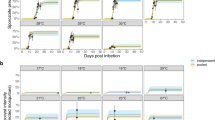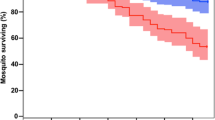Abstract
MOSQUITOES need a certain amount of moisture in the atmosphere in which they live. From the investigations of earlier workers1, we find that changes in the humidity influence the longevity of the insect host and consequently that of the parasite within ; low, as well as very high, humidities are detrimental. But if a mosquito is infected with the malaria parasite (Plasmodium), the size of the oocysts is not influenced by atmospheric humidity. As to the number of oocysts, according to Gill's work, this is not influenced either. In the work done here, Aedes ægypti were fed on chicks infected with Plasmodium gallinaceum, and the speed and degree of development of oocysts in the mosquito under various climatic conditions were studied.
This is a preview of subscription content, access via your institution
Access options
Subscribe to this journal
Receive 51 print issues and online access
$199.00 per year
only $3.90 per issue
Buy this article
- Purchase on Springer Link
- Instant access to full article PDF
Prices may be subject to local taxes which are calculated during checkout
Similar content being viewed by others
References
Gill, C. A. Trans. Roy. Soc. Trop. Med. Hyg., 14, 77 (1921). Huff, C. G., Amer. J. Hyg., 34, 18 (1941). Mayne, B., Ind. J. Med. Res., 17, 1119 (1930). Mehta, D. R., Rec. Mal. Surv. Ind., 4, 261 (1934).
Author information
Authors and Affiliations
Rights and permissions
About this article
Cite this article
RAGAB, H. Effect of Humidities and Temperatures on the Size and Number of Oocysts of Plasmodium gallinaceum Transmitted by a Mosquito. Nature 163, 643–644 (1949). https://doi.org/10.1038/163643b0
Issue Date:
DOI: https://doi.org/10.1038/163643b0
Comments
By submitting a comment you agree to abide by our Terms and Community Guidelines. If you find something abusive or that does not comply with our terms or guidelines please flag it as inappropriate.



